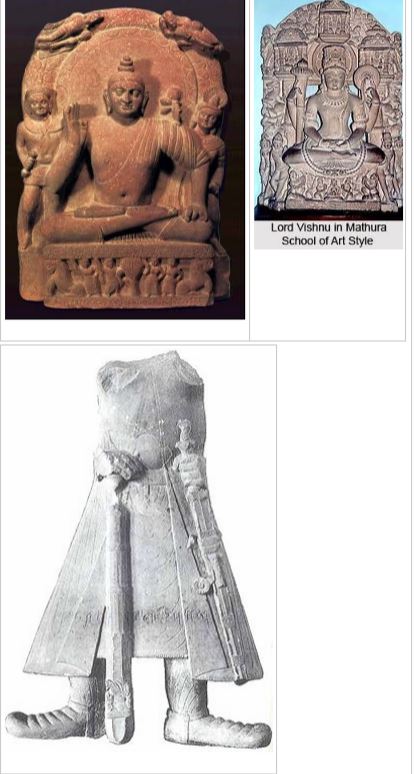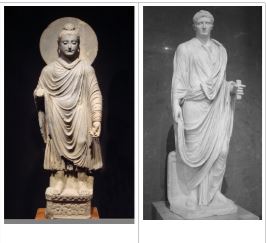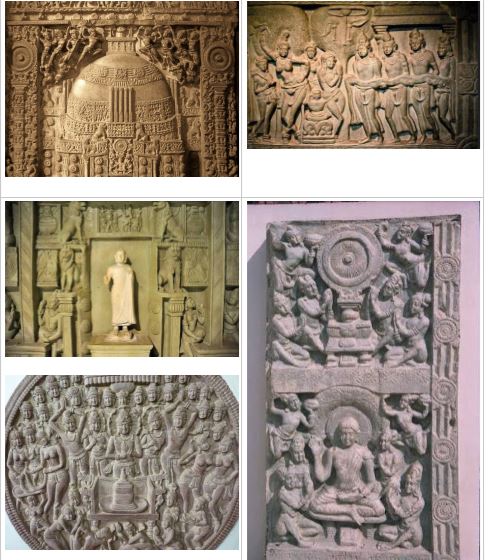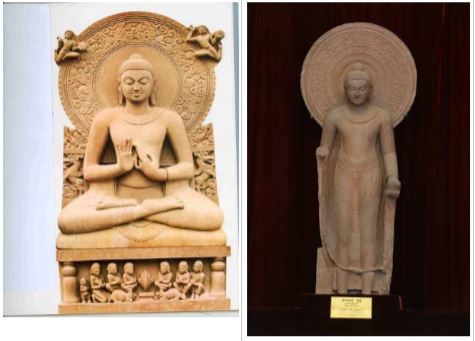Table of Contents
Post Mauryan Sculpture
This article deals with topic titled ‘Post Mauryan Sculpture .’ This is part of our series on ‘Culture’ . For more articles , you can click here
Introduction
- In Post Mauryan Phase, Shungas, Kushanas & Satavahanas ruled.
- This phase paved the way for different schools of sculpture (like Mathura School of Art, Gandhara School etc & these School of arts gave way to Temple architecture)
- Factors which developed art and culture in this phase
- Geographical expanse of respective kingdoms
- Local available material
- Local traditions of craftsmanship
- Political requirements
- Tastes of royalty (Satavahana queens gave donations to Buddhist monks in Western Ghats and various caves like Karle, Kanheri etc came up there)
- Religious inclination of the dynasties (these three dynasties patronised Brahmanism but at the same time kept on patronising Buddhism and Jainism although not at that great scale as Ashoka)
- In this phase, although state patronage continued ( on lesser scale) but local players like Guilds and common people started to play important role in Art and Sculpture .
- In this age, different motifs of yakshas& yakshis became very favourite. Shilabhanjika motif ie grasping the tree motif was very popular during this age

Shilabhanjika from Torana of Sanchi
Kushana Period
- Art & sculpture developed in this period at great pace. This was beginning of Golden phase of Indian Art
- Kushana rule opened the gateway for active interaction of Indian Culture with those of Central & Eastern Asia . These further paved the way for exchange of ideas with other advanced traditions of ancient world like Graeco-Roman Traditions
- Development of various schools of art took place in this period
- Era of excellence in several fields including religion , philosophy & literature.
- Most important development took place in Buddhism . During Kushana rule , first major Schism took place in Buddhism when Buddhism divided to Hinayana & Mahayana . Mahayana provided great impetus for development of sculpture because Buddha in this school can be shown in human form.
Mathura & Gandhara school of Art
- Both Gandhara & Mathura were part of Kushana rule

- First Buddha appeared in Mathura & later spread to other places including Gandhara
- Both developed under political hegemony of Kushanas
- In due course of time both schools merged
1 . Mathura School of Art
| Origin | – In heartland of India & percolation of foreign influence was almost none. – No foreign influence,but later fertilised with Gandhara School – Initial development took place indigenously inspired by Yakshas |
| Material | Spotted red sandstone (from Sikri mines) |
| Features | – Mathura image makers didn’t intend to sculpt anatomically correct Budha & were images were generally disproportionate. – Images were compositions of 32 major & 80 minor laksana. – Images were very inexpressive Buddha has been shown sitting cross legged. – Boldness in expression . Images express more of power & less of compassion – Hair aren’t dressed. – Drapery and clothes are shown in simple manner – Images are mainly in Abhayamudra |
| Centes | Mathura, Sarnath, Kosambi |
| Images | – Buddha – Jain Tirathankaras – Images of hindu gods and goddesses like Vishnu, Shiva, Parvati, Kuber etc – Image of Emperors – most important being that of Kanishka |
| Patrons | Developed under Kushanas & Zenith during the Gupta period 325-600 AD |

2. Gandhara School of Art
| Origin | – Gandhara region is in North West of Subcontinent and Silk Road passes through it. Also it is on border of Subcontinent. Hence , ideas from different regions like from China, Greek, Roman, Persian kept on coming in this region. As a result of mixing of all ideas along with Indian ideas, totally different school came up here. – Strong Greeko-Roman influence- based on greco- roman norms (but influence of Indian Traditions was strong as well) Also known as Greco-Buddhist school of Art |
| Material | Black stone & Stucco |
| Features | – Closely connected with Mahayana Buddhism – Has distinct influence of old Greek School of Art. => It used the Indian themes but used the material (Stucco) & ideas of Graeco -Romans – Main theme of this school was Buddha & Bodhisattvas. |
| Image Features | – Finer details and realistic images – Buddha carved out in various mudras – Curly/wavy hair,anatomically accurate,spatial depth. – Wrinkles on skin, compassion and muscular frame of body – Transparent garments , fold of garment very natural , flowing drapery Images are very expressive & muscularity of body is depicted very well (Greek gods are also depicted in masculine posture) – Buddha is depicted like Greek God Apollo |
| Centres | Taxila,Begram, Bamiyan & Peshawar (Afghanistan & NW India) |
| Patrons | Shakas & Kushanas |

Greek , Roman and Indian Influence
| Greek | – Depiction of Buddha as a ‘man-god’ in Gandharan sculpture is inspired from Greek mythology. Greek sculpture believed in mythological and idealist statues, while the Roman sculpture was more realistic (Greek Sculptures = God | Roman Sculptures = Mainly used to make statues of Kings and Generals) – Stucco plaster, which was commonly used in Greek art, was widely used in Gandharan artwork – Wavy hair (Romans have adopted wavy hair from Greek) – Masculinity ( Greek gods were always shown muscular) |
| Roman | – Roman Sculpture developed from Greek Sculpture. Hence, there was large similarity in them but differences were visible as well. Drapery Drapery of the robes on Buddha was also very similar to the drapery on Roman imperial statues. (refer image below) |
| Indian | – Jewelry indicated was Indian – Idea of Buddhism is Indian. |

Mathura vs Gandhara School of Art
This type of question is very important for State Level PCS examinations.
| Mathura school | Gandhara school | |
| Origin | No foreign influence & indigenous development (although later cross fertilised with Gandhara schools ) | Strong Greek-Roman influence . Graeco Buddhist school of art . Initially inspired by Hellenistic features. |
| Material used | Spotted red sandstone | Stucco |
| Religions | All 3 = Buddhism , Jainism & Hinduism | Only Buddhism |
| Image feature | – Not much attention to detailed sculpting – Buddha is stout | – Finer details – Realistic images – Buddha in various mudras |
| Area | Mathura, Kosambi | Taxila, Bagram, Bamiyan etc |
| Patronage | Kushanas & later Guptas | Kushanas & Shakas |
Amravati School of Art
During the time of Satavahanas , Amravati & Nagajunakonda developed as center of art popularly known as Amravati School of Art aka Vengi School of Art.
| Location | – Amravati is in Guntur dist of AP. – Aka Vengi School of Art & developed in lower valleys of Krishna -Godavari region |
| Patrons | Satavahans & Ischvakus |
| Material | White Marble |
| Place | Andhra Pradesh (Krishna -Godavari Valley) |
| Theme | – Buddha life & Jataka stories – Both Mahayana & Hinayana – There is emphasis on the narrative element with stories from the life of Buddha and Bodhisattva dominating such episodes relating to the Birth, the miracles, Enlightenment |
| Features | – Curly hairs of Buddha influenced by greeks – Kings,princes,palaces have got prominence – Its gateways has images of lion – Amravati figures are lean, beautiful, curvy & mobile even when resting (in this respect close to Gandhara) – Flowers & lotus motifs are carved frequently – Various postures create an interest in activities of each individual \- Most of sculptures are joyful. – Female figurines are made in different postures. Feminine beauty is better depicted in Amravati than in Mathura School of Art. – Amravati School of Art had a great influence on the later period sculpture of South India and even Sri Lanka & South East Asia. |

Sarnath School
- Sarnath is place near Varanasi and is famous as place where Buddha delivered his first sermon
- Sarnath School developed much later than Gandhara & Mathura School and some scholars opine that development of Sarnath school is closely associated with the Gupta Period.
- It is also associated with
Buddha (and Boddhisatvas are also shown)
- Halo is very much developed .
- Hair are developed than Mathura (but lesser than Gandhara) – small dot like structure
- Drapery isn’t developed – Flows are simple and not showing natural cloth like Gandhara . Almost transparent
- Made of Red Sandstone
- Calm & inner tranquility is shown
- Very popular for preaching Buddha ie Dharmachakramudra is most common in this .
- Here Stupa Architecture was very much different than other places like Sanchi . Eg Dhamekh Stupa & Chaukhandi Stupa both belonging to this school.

